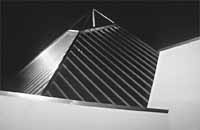Resounding architecture
Two local architects take home prestigious AIA Idaho Design Awards
 "The [Ketchum] Design Review Board is
dedicated to the perpetuation of mediocrity. It guarantees the banal and the pedestrian.
There was no Design Review Board on this project in Blaine County. If there was it would
not have been successful. Design review boards are useless." (Photo by Willy
Cook)
"The [Ketchum] Design Review Board is
dedicated to the perpetuation of mediocrity. It guarantees the banal and the pedestrian.
There was no Design Review Board on this project in Blaine County. If there was it would
not have been successful. Design review boards are useless." (Photo by Willy
Cook)
Jack Smith, Ketchum architect
By HANS IBOLD
Express Staff Writer
 An Eagle Creek home designed by Ketchum architect Jack Smith
took home the prestigious AIA Idaho Honor Award. Photo by Tim Brown
An Eagle Creek home designed by Ketchum architect Jack Smith
took home the prestigious AIA Idaho Honor Award. Photo by Tim Brown
It was perhaps the mystical, tepee-like forms rising out of the Eagle
Creek house designed by Ketchum architect Jack Smith that caught the attention of judges
for the American Institute of Architects (AIA), Idaho Chapter.
AIA judges, who are three of Seattle’s most prestigious architects,
awarded Smith an Honor Award, the highest AIA design award, for the Eagle Creek house last
week.
Another Ketchum architect, Jim McLaughlin, received a Merit Award for a
fishing lodge his firm, McLaughlin and Associates, designed in New Zealand.
The AIA design awards are given out every two years to highlight exemplary
architectural work and to increase public awareness about architectural design. The AIA
Honor Award has been described as architecture’s Nobel Prize.
This year, judges chose from a field of 29 architects from across the
state and gave out an Honor Award, two Merit Awards and a Citation Award.
The choice of Smith’s Eagle Creek house brought a kind of sweet
justice to the architect, who was criticized by skeptical neighbors during planning and
construction of the house.
Neighbors claimed the house would clash with the natural landscape, but
the AIA judges saw it differently.
"The Eagle Creek house works well on the land," wrote the judges
in a joint statement explaining their decision.
Judges also cited Smith’s "mystical tepees," which bring
light into the house and "set a scenographic quality."
"This house is pure poetry," wrote one of the judges, Thomas
Bosworth.
That comment resounded with Smith, who said in an interview that the
design of the house came from "understanding and interpreting the site and the
clients’ dreams and making art out of it.
"The site, the client and the architect are the form-givers in
architecture," he said. "When the three come together, you can get
somewhere."
The most striking features of the Eagle Creek house are its five
glass-capped pyramids, which reflect light on the outside and draw light into interior
spaces. Those interior spaces are given a hierarchical and spacial order by the pyramids.
The pyramids also serve as a metaphor, Smith said, for the mountainous
surroundings and for Native American culture.
"The house fits the site like a glove," said owner Steve Child
in a telephone interview from Salt Lake City, where he and his wife, Paula, live
part-time. "It’s perfectly in tune with its environment."
The Childs plan to move to the Eagle Creek house full-time within the next
two years, a transition that Steve Child said he is excited about.
"The longer we’re up there, the more comfortable we
become," Child said. "The house has a character that unravels like an
onion."
Child said that Smith "bent over backwards" to make them part of
the design process, "to probe our desires and our lifestyles."
That architect-client relationship was crucial to the successful design of
the house, Smith said.
"The most successful projects are ones where the client and architect
are one spirit," Smith said. "But the client is not the leader. The contractor
is not the leader. The architect is, because art is an individual thing.
"An architect interprets the clients’ dreams and makes it a
reality. The architect goes beyond their dreams. The architect actualizes the
clients’ potential."
That can’t happen, Smith added, when the city of Ketchum’s
Design Review Board applies its standards. The Design Review Board consists of Ketchum
Planning and Zoning commissioners.
"The Design Review Board is dedicated to the perpetuation of
mediocrity," Smith said. "It guarantees the banal and the pedestrian. There was
no Design Review Board on this project in Blaine County. If there was it would not have
been successful. Design review boards are useless."
Poetry is lacking in the city of Ketchum’s architectural landscape,
Smith said.
"I don’t agree with most of what I see going on architecturally
here," he said. "The notion of rusticism, for example, is made up by an
outsider. Log cabins weren’t even here in the early days.
"The earliest buildings were brick, like the Mercantile building, or
they were white-painted, clapboard-sided buildings with metal roofs."
Some of the city’s newer buildings, such as the Davies Reid tribal
arts gallery on First Avenue, don’t fit in, Smith said.
"It’s a transplant," Smith said of the Davies Reid
building. "It has no business being here. It’s not metaphorical. It’s
literal. It’s a transplanted image that has no place here."
What should the local architectural landscape consist of?
"I want to see here what should be here in terms of place and
time," Smith said. "We need to hold on to values and principles from tradition
but allow the world to continue and change, because it will change. We need to learn to
flow with change and help change be appropriate."
Jim McLaughlin had to overcome "incredibly strict design review
guidelines," he said, to build his award-winning fishing lodge near Queenstown, New
Zealand.
Tucked into a hill overlooking a lake, the lodge was honored by the AIA
judges for its "unpretentious use of natural materials."
McLaughlin said in an interview that he combed New Zealand to find the
natural materials used to construct the lodge.
"We wanted to create the impression that the building had been on the
site for decades," McLaughlin said.
To achieve that effect, he used aged timbers, stone from the immediate
surroundings and a slate roof.
"It’s a grand building, yet a simple idea," the judges
wrote in their joint statement.
Grand indeed. The lodge features eight suites, two dining rooms, a bar, a
huge commercial kitchen, a spa, a game room, a fishing room, an onsite helicopter pad and
a man-made stream that snakes around the building.
Want to go? It’ll cost you $1,800 a night plus a few thousand more to
get from here to the remote New Zealand site.